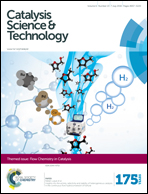Masking effect of copper oxides photodeposited on titanium dioxide: exploring UV, visible, and solar light activity†
Abstract
A series of copper oxide loaded TiO2 was prepared by a photodeposition method. It was clarified through XANES that the added copper species solely existed as highly dispersed Cu(II) and it remained as Cu(II) after the photocatalytic reaction. The prepared CuO/TiO2 with various contents (0.1–5 mol%) were used as photocatalysts for 2,4-dichlorophenoxyacetic acid (2,4-D) degradation under UV, visible, and solar simulator irradiation. Under UV light irradiation, the photocatalytic activity of 2,4-D decomposition increased by a maximum factor of 4.3 compared with unmodified TiO2 when TiO2 was loaded with 0.75 mol% CuO. In contrast, under visible light and solar simulator irradiation, the optimum loading of CuO was much lower (0.1 mol%) and enhancements of 22.5 and 2.4 times higher activities were observed, respectively. These results showed that the different masking effects due to the different light sources led to different optimum amounts of CuO, and the added CuO mostly contributed to the visible light activity of TiO2. Therefore, in addition to the increased charge separation and improved visible light absorption, the masking effect shall also be considered in designing highly active photocatalysts under visible and solar light irradiation.


 Please wait while we load your content...
Please wait while we load your content...